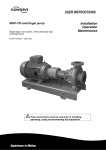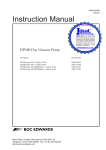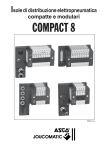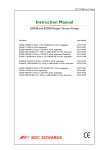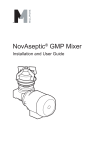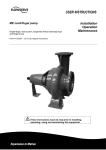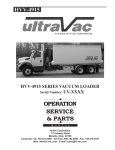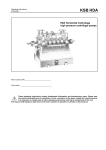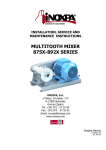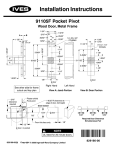Download TS32V18 and TS56V18 Blower
Transcript
HB7300880 Issue D Original Instruction Manual TS32V18 and TS56V18 Truck Blowers TS32V18 and TS56V18 Truck Blowers CONTENTS PAGE Ipsitech 8210(C)06 Section 1 INTRODUCTION 1 1.1 1.2 1.3 1.4 Scope and definitions Description Applications Principle of operation 1 1 1 2 2 TECHNICAL DATA 5 2.1 2.2 2.3 2.4 2.5 2.6 2.7 2.8 Operating and storage conditions Mechanical data Noise and vibration data Performance Lubrication data Connections Materials of construction Item Numbers 5 5 5 6 7 7 7 8 3 INSTALLATION 13 3.1 3.2 3.3 3.4 3.5 3.5.1 3.5.2 3.6 3.7 3.8 3.9 Installation safety System design Unpack and inspect Locate the blower Connect the blower into your system Introduction Connect the blower inlet and outlet Fill the blower with oil Fit the drive/transmission Check the direction of rotation Commission the blower 13 13 14 14 15 15 15 15 15 16 16 4 OPERATION 17 4.1 4.2 4.3 4.4 General operational safety Start-up Operation with maximum differential pressure Shut-down 17 17 17 18 5 MAINTENANCE 19 5.1 5.2 5.3 5.4 5.4.1 5.4.2 5.5 5.6 5.6.1 Safety information Maintenance plan Inspect the oil-level sight-glasses Check the oil levels Gear end cover Drive end cover Inspect the system installation Change the oil Gear end cover 19 19 20 20 20 20 21 21 21 Nov 06 i Page i Issue C TS32V18 and TS56V18 Truck Blowers CONTENTS (CONTINUED) PAGE Section ii Page 5.6.2 5.7 5.8 5.9 Drive end cover Replace a vent filter (when necessary) Overhaul the blower Fault finding 21 21 21 21 6 STORAGE AND DISPOSAL 25 6.1 6.1.1 6.1.2 6.1.3 6.2 Storage Preparation Preparation for long-term storage Preperation for use after long-term storage Disposal 25 25 25 25 26 7 SERVICE AND SPARES 27 7.1 7.2 7.3 Introduction Service Spares 27 27 27 RETURN OF Ingersoll Rand EQUIPMENT Nov 06 ii Issue C TS32V18 and TS56V18 Truck Blowers PAGE iii ILLUSTRATIONS Figure 1 2 3 Page Components of the blower Blower orientations, shaft positions and gas flow Blower dimensions 3 9 11 TABLES Table 1 2 3 4 5 6 7 8 9 10 11 12 13 14 15 Nov 06 Page Operating and storage conditions Mechanical data Noise and vibration data TS32V18 performance data TS56V18 performance data Lubrication data Connections data Construction materials data Item Numbers Checklist of items Maximum drive shaft loadings Maintenance plan Fault finding Suitable protective oils Spares iii 5 5 5 6 6 7 7 7 8 14 15 19 22 25 27 Issue C TS32V18 and TS56V18 Truck Blowers 1 INTRODUCTION 1.1 Scope and definitions 1.2 Refer to Figure 1. The TS32V18 and TS56V18 blowers are positive displacement blowers, cooled by ambient air circulation. The blowers are supplied in ‘bareshaft’ form. You must connect your own coupling or belt drive system (see Section 3.7) to the drive shaft in order to operate the blower. Read this manual before you install the blower. Important safety information is highlighted as WARNING and CAUTION instructions; you must obey these instructions. The use of WARNINGS and CAUTIONS is defined below. The blowers are available in two different versions: • ‘H’ version blowers (which can be supplied with the drive shaft at the left or right) are installed horizontally, and provide for a vertical gas flow through the blower. WARNING • ‘V’ version blowers (which can be supplied with the drive shaft at the top or bottom), are installed vertically, and provide for a horizontal gas flow through the blower. Warnings are given where failure to observe the instruction could result in injury or death to people. Refer to Section 2.8 for the Item Numbers of the different blower versions. CAUTION Cautions are given where failure to observe the instruction could result in damage to the equipment, associated equipment and process. 1.3 Applications The blowers are suitable for pumping ambient air, and non-flammable gases, gas mixtures and dusts. The blowers are not suitable for pumping flammable or pyrophoric gases, gas mixtures and dusts. US imperial units are used throughout this manual. An identification and rating plate will be fitted to the top of the blower body casing, or to the gear end cover. This plate provides specific details about the blower, such as its Item Number and so on. The materials of construction of the blowers are specified in Section 2.7. Before you use the blower, you must ensure that these materials are compatible with the gases and vapours which you will pump or which may exist in the external atmosphere. The following warning and other symbols are on the blower: Warning refer to accompanying documentation. You must ensure that your blower is suitable for your application. Warning hot surfaces. If you have any doubts as to the suitability of the blower for your application, contact your supplier or Ingersoll Rand for advice. 1 Issue C PAGE 1 INTRODUCTION This manual provides installation, operation and maintenance instructions for the Ingersoll Rand TS32V18 and TS56V18 Truck Blowers, abbreviated to "blowers" in the remainder of this manual. You must use the blower as specified in this manual. Nov 06 Description TS32V18 and TS56V18 Truck Blowers 1.4 PAGE 2 Principle of operation INTRODUCTION The blowers incorporate a pair of two-lobe contrarotating rotors. One of the rotors is driven by the drive shaft. The other rotor is maintained in the correct phase relation by timing gears in the gear end cover. As the rotors turn, gas which enters the inlet is trapped in the chambers which form between the rotors and the body casing, and is eventually forced out of the blower at the discharge (outlet). The rotors can operate (rotate) in either direction. The direction of gas flow through the blower is therefore determined by the direction of rotation of the drive shaft, as shown in Figure 2. You must ensure that your drive system (connected to the drive shaft) is correctly configured for your system design. Issue C 2 Nov 06 TS32V18 and TS56V18 Truck Blowers PAGE 3 INTRODUCTION A Gear end cover/drive end cover vent filters 1. 2. 3. 4. 5. 6. 7. 8. Gear end cover Oil filler plug (gear end) Lifting brackets Inlet/outlet Oil filler plug (drive end) Drive end cover Drive shaft Oillevel sightglass (drive end) 9. Oil drain plug (drive end) 10. Mounting feet 11. Inlet/outlet 12. Oil drain plug (gear end) 13. Oillevel sightglass (gear end) 14. Vent filter 15. Gear end/drive end vent port Figure 1 Components of the blower Nov 06 3 Issue C TS32V18 and TS56V18 Truck Blowers 2 TECHNICAL DATA 2.1 Operating and storage conditions PAGE 4 TECHNICAL DATA 4 to 104 o F 4 to 176 o F 90% 3280 ft Ambient operating temperature range Ambient storage temperature range Maximum ambient operating humidity Maximum operating altitude * Table 1 Operating and storage conditions * The blowers may be suitable for operation at higher operating altitudes, depending on your installation and application: contact your supplier or Ingersoll Rand for advice. 2.2 Mechanical data Dimensions See Figure 3 Mass TS32V18 TS56V18 1036 lb 1466 lb Table 2 Mechanical data 2.3 Noise and vibration data Note: The noise and vibration data values given below are maximum values, with pipelines connected to the blower inlet and outlet. The actual values will depend on the installation and the operating conditions. Noise level 95 dB(A) Vibration level 0.71 inch s 1 Table 3 Noise and vibration data Issue C 4 Nov 06 TS32V18 and TS56V18 Truck Blowers 2.4 Performance Note 1: The "given vacuums" specified in Tables 4 and 5 are the differential pressures across the blower (that is, the differential pressures between the blower inlet and outlet). Note 3: The "r.p.m./r min-1" rotation speeds specified in Tables 4 and 5 are provided for information only, to identify blower performance at the specified speed. During operation, the rotation speed of the blowers need not be limited to these specified speeds. Note 4: Contact your supplier or Ingersoll Rand for details of pressure operation performance. Thr oughput (cfm) and absor bed power (h.p.) at given vacuum r.p.m./ r min 1 3 inch Hg 6 inch Hg 9 inch Hg 12 inch Hg 15 inch Hg 16 inch Hg 18 inch Hg cfm h.p. cfm h.p. cfm h.p. cfm h.p. cfm h.p. cfm h.p. cfm h.p. 1200 1140 10 1020 20 950 28 840 36 * * * * * * 1700 1690 15 1620 28 1500 40 1400 65 * * * * * * 2200 2300 17 2220 35 2110 50 1990 68 1910 83 1870 89 * * 2400 2530 20 2450 38 2360 55 2220 73 2150 89 2100 95 2020 110 2700 2880 22 2800 43 2700 65 2590 85 2500 103 2460 110 2380 123 3200 3490 27 3400 50 3300 75 3180 93 3080 120 3050 129 2960 146 * Contact your supplier or Ingersoll Rand for details. Table 4 TS32V18 performance data Thr oughput (cfm) and absor bed power (h.p.) at given vacuum r.p.m./ r min 1 3 inch Hg 6 inch Hg 9 inch Hg 12 inch Hg 15 inch Hg 16 inch Hg 18 inch Hg cfm h.p. cfm h.p. cfm h.p. cfm h.p. cfm h.p. cfm h.p. cfm h.p. 1000 1800 13 1660 28 1550 42 1400 55 * * * * * * 1350 2520 20 2360 37 2280 58 2120 73 1960 88 * * * * 1700 3240 24 3080 49 2980 70 2840 92 2680 112 2520 119 * * 2050 3960 30 3800 58 3720 85 3560 112 3400 135 3080 144 3080 160 2400 4680 35 4520 65 4400 100 4280 130 4120 160 3960 170 3800 185 * Contact your supplier or Ingersoll Rand for details. Table 5 TS56V18 performance data Nov 06 5 Issue C 5 TECHNICAL DATA Note 2: In Tables 4 and 5, 18 inch Hg is the maximum differential pressure at which the blower can operate. If you operate the blower for extended periods at this maximum differential pressure, the blower will overheat: see Section 4.3. PAGE TS32V18 and TS56V18 Truck Blowers 2.5 PAGE 6 Lubrication data TECHNICAL DATA Recommended oil Mobil SHC 630, or equivalent 220 cST oil Oil capacity Drive end cover Gear end cover TS32V18 0.32 US gal 0.63 US gal TS56V18 0.5 US gal 1.11 US gal Table 6 Lubrication data 2.6 Connections Inlet/outlet TS32V18 TS56V18 8 inch ANSI 12 inch ANSI Table 7 Connections data 2.7 Materials of construction Body casing End covers Rotors Shafts Gears EN GJL 200 cast iron EN GJL 200 cast iron EN GJS 40015 ductile iron EN GJS 40015 ductile iron 817 M 40 carbon steel Gaskets Main lip seals Shaft lip seals CAFF (Klingeritâ ) Vitonâ Nitrile rubber Table 8 Construction materials data â Klingerit is a registered trademark of Klinger AG. Viton is a registered trademark of Dupont. Issue C 6 Nov 06 TS32V18 and TS56V18 Truck Blowers 2.8 Item Numbers PAGE Blower TS32V18V TS56V18V TS45V18H Figur e 2 detail Item Number Bottom A, B HB7310032 Top C, D HB7315032 Lefthand side G, H HB7305032 Righthand side E, F HB7310032 Bottom A, B HB7310056 Top C, D HB7315056 Lefthand side G, H HB7305056 Righthand side E, F HB7310056 7 TECHNICAL DATA TS32V18H Shaft position Table 9 Item Numbers Nov 06 7 Issue C TS32V18 and TS56V18 Truck Blowers PAGE 8 TECHNICAL DATA Inlet gas stream Outlet gas stream Direction of drive shaft rotation Figure detail A B C D E F G H Blower Orientation Vertical Vertical Vertical Vertical Horizontal Horizontal Horizontal Horizontal Shaft position Bottom Bottom Top Top Right Right Left Left Rotation direction Clockwise Anticlockwise Anticlockwise Clockwise Anticlockwise Clockwise Clockwise Anticlockwise Figure 2 Blower orientations, shaft positions and gas flow Issue C 8 Nov 06 TS32V18 and TS56V18 Truck Blowers PAGE Key Dimensions: inches TS56V18 A 27.50 28.00 a 1.00 2.00 Bv 7.00 15.00 Bh 13.00 23.00 C 28.74 30.47 Dv 8.97 20.70 Dh 14.97 28.07 dv 2.50 5.00 dh 2.50 5.00 E 3.00 4.00 e 2.00 2.62 F 15.75 18.90 G 0.39 0.47 H 12.00 14.00 hv 9.00 10.00 hh 9.00 10.00 Iv 23.13 28.11 Ih 17.70 20.11 L 42.35 46.78 L1 20.70 22.45 L2 21.65 24.33 OÆ 10.00 12.00 SÆ 0.55 1.00 V 3.74 4.48 W 3.90 4.70 Y 0.50 0.625 ZÆ 2.00 2.75 TECHNICAL DATA TS32V18 9 Figure 3 Blower dimensions: key Nov 06 9 Issue C TS32V18 and TS56V18 Truck Blowers PAGE 10 TECHNICAL DATA 1. 2. 3. 4. Vertical blowers: end view Vertical blowers: side view Horizontal blowers: end view Horizontal blowers: side view Figure 3 Blower dimensions Issue C 10 Nov 06 TS32V18 and TS56V18 Truck Blowers 3 INSTALLATION 3.2 Your system must be suitably designed for correct operation of the blower. Note that: CAUTION • You must design suitable pipelines to fit the blower inlet/outlet connections. Refer to Section 2.6 and to Figure 3 for the dimensions of the blower inlet and outlet connections. • Your system design must ensure that, when the blower is in its final operating location, you can see the oil-level sight-glasses and can access the oil filler and drain plugs. Installation safety WARNING Obey the safety instructions listed below and take note of appropriate precautions when you install the blower. • Your system design must ensure that the blower cannot be operated with the inlet or outlet pipelines obstructed. We also recommend that your system incorporates an emergency stop facility which, once activated, must be manually reset before the blower can be operated again. • A suitably trained and supervised technician must install the blower. • Ensure that debris and dust does not get into the blower when you install it. Also note the following when you design your system: • Check that all of the required components and tools are available and of the correct type before you start to install the blower. • We recommend that you incorporate a filter in the inlet pipeline to the blower, to prevent the entry of particles or debris into the blower. • Where applicable, use suitable new gaskets/ seals to connect the blower into your system. Do not reuse old gaskets/seals. • The blower must be level (within 15o in any of the horizontal mounting axes) for correct operation. • If you will fit the blower into an existing system, disconnect the power from the drive system before you start installation, so that the drive system cannot be operated accidentally. • We recommend that you incorporate silencers, to attenuate the pulsations in the inlet/outlet gas streams. • There must be sufficient free space around the blower, for adequate cooling-air circulation. • If required, install your own acoustic enclosure around the blower. If you do install such an enclosure, ensure that there is sufficient space for cooling-air flow around the blower: see above. Nov 06 11 Issue C PAGE 11 INSTALLATION Ingersoll Rand will accept no liability or warranty claims if your installation includes any modifications or additions to the blower without the prior written approval of Ingersoll Rand, or if the blower is incorrectly installed. 3.1 System design TS32V18 and TS56V18 Truck Blowers 3.3 Unpack and inspect PAGE INSTALLATION 2. Locate the blower WARNING WARNING Use suitable lifting equipment to move the blower. If you do not, you can injure yourself or damage the blower. Refer to Section 2.2 for the mass of the blower. Use suitable lifting equipment to move the blower. If you do not, you can injure yourself or damage the blower. Refer to Section 2.2 for the mass of the blower. 12 1. 3.4 Attach a suitable fork-lift truck or pallet truck to the lifting brackets on the blower and move the blower, on its pallet, close to where you will install it. Ensure that the operating location is clean and free from debris and oil. You must ensure that when the blower is in its required operating location, all of the mounting feet are in the same plane, flat on the mounting platform. The platform must be firm and level, with a maximum flatness deviation less than 0.026 inch ft-1. Remove all packing materials and protective covers and check the blower. If the blower is damaged, notify your supplier and the carrier in writing within three days; state the Item Number of the blower together with your order number and your supplier's invoice number. Retain all packing materials for inspection. Do not use the blower if it is damaged. 3. Check that you have received the items listed in Table 10. If any item is missing, notify your supplier in writing within three days 4. Look at the blower rating and identification plate and check that the blower is suitable for use in your system. If the blower is not suitable for use in your system, do not continue to install the blower: contact your Supplier or Ingersoll Rand. Do not use shims or spacers under the mounting feet to level the blower. Use the following procedure to locate the blower: 1. Use the lifting equipment to move the blower to its required operating location: use the method given in Step 1 of Section 3.3. 2. Disconnect your lifting equipment from the blower. 3. Fit suitable bolts through the fixing holes in the mounting feet (Figure 1, items 10), to secure the blower in position. If the blower is not to be used immediately, replace the protective covers. Store the blower in suitable conditions, as described in Section 6.1. Quantity Descr iption Check (3) 1 Blower o * Gear end cover/drive end cover oil o * If you have ordered oil, you will receive sufficient quantity of the correct oil to fill the blower: see Section 2.5. Table 10 Checklist of items Issue C 12 Nov 06 TS32V18 and TS56V18 Truck Blowers 3.5 Connect the blower into your system 3.5.1 Introduction 3.6 13 Before you commission and operate the blower, you must fill the blower with oil: refer to Section 5.4. • Support your system pipelines and other components, to prevent loading of the inlet and outlet ports on the blower. 3.7 Fit the drive/transmission • Incorporate flexible components in your system, to minimise noise and vibration. WARNING • Where necessary, use gaskets/seals which are compatible with the gases which will be pumped, and with the operating conditions. You must fit suitable guards to protect people from rotating/ moving parts. • The leak tightness of your system connections must be in accordance with the requirements of your applications. 3.5.2 You must use a suitable coupling or a belt drive and transmission system to connect your drive to the blower. Connect the blower inlet and outlet Your drive and transmission system design must ensure that the radial and axial loadings on the blower drive shaft are as low as possible. The radial and axial loadings must be below the maximum loadings specified in Table 11 (page 13). Use the following procedure to connect the blower into your system: Use a suitable gasket/seal to connect your inlet pipeline to the blower inlet (Figure 1, item 4 or 11). Connect the components of the drive and transmission system to the blower drive shaft (Figure 1, item 7) as described in the manufacturer’s instructions supplied with the components. Use a suitable gasket/seal to connect your outlet pipeline to the blower outlet (Figure 1, item 4 or 11). Blower Radial * Axial * TS32V18 1.3 x 10 3 lbf 1.5 x 10 2 lbf TS56V18 2.7 x 10 3 lbf 2.9 x 10 2 lbf * These are the maximum loadings that can be applied to the end of the drive shaft. Table 11 Maximum drive shaft loadings Nov 06 13 Issue C INSTALLATION Ensure that you use the correct grade of oil and that the oil levels are correct. If you do not, the blower may be damaged during operation, or its performance may be affected. • For optimum performance, ensure that the system pipelines connected to the blower are as short as possible. 2. PAGE CAUTION Take note of the following when you connect the blower into your system: 1. Fill the blower with oil TS32V18 and TS56V18 Truck Blowers 3.8 Check the direction of rotation PAGE 14 3.9 INSTALLATION WARNING CAUTION If you remove a guard during the following procedure, ensure that you do not come into contact with the shaft, the coupling/belt or the drive system when you operate the blower. If you do, you may be injured by the rotating components. Commission the blower as described below before you operate the blower as described in Section 4. After you have installed the blower, use the following procedure to commission it and prepare it for subsequent operation: CAUTION Ensure that the blower rotates in the correct direction. If it does not, your system will not operate correctly. 1. Ensure that any valves in the inlet and outlet pipelines are open. 2. Engage your drive and transmission system to start the blower. 3. Operate the blower, with no gas load, for at least 15 minutes. During this time: After you have connected the drive/transmission, check the direction of rotation of the blower as follows: 1. 2. 3. 4. Commission the blower • Monitor the external surfaces of the blower and check for ‘hot spots’ (that is, areas which are unusually hot). If necessary (that is, to make it easier to see the blower drive shaft), temporarily remove any guard over the drive coupling or belt. • If any hot spots persist at the end of the 15 minutes, contact your supplier or Ingersoll Rand for advice. Refer to Figure 1. Watch the blower drive shaft (7) while you start up the blower (refer to Section 4.2), then shut down the blower (refer to Section 4.4) after two seconds or so. 4. Check that the blower drive shaft (7) rotated correctly in the expected direction. (This depends on your application and installation configuration: see Section 1.4.) Continue to operate the blower with a representative gas load, and check that the pump operates correctly and provides the required performance. If necessary, refer to Section 5.9 if any fault conditions occur. 5. If the direction of rotation was incorrect: • Check the installation of the drive and transmission system and reconfigure as appropriate. Disengage your drive and transmission system to stop the blower. The blower is now ready for normal operation. • Perform the direction of rotation check from Step 2 again, to ensure that the blower now rotates in the correct direction. 5. If you have removed the guard over the drive coupling or belt (as in Step 1 above), refit the guard. Issue C 14 Nov 06 TS32V18 and TS56V18 Truck Blowers 4 OPERATION • Do not attempt to use the blower to pump liquids. The blowers are not designed for this application. CAUTION Ingersoll Rand will accept no liability or warranty claims if your blower is used on applications or in a way prohibited in this manual, or not specified in this manual. 4.2 4.1 Start-up General operational safety 1. Check the oil-levels in the blower: refer to Section 5.4. 2. Ensure that any valves in the inlet and outlet pipelines are open. 3. Engage your drive and transmission system to start the blower. WARNING Obey the safety instructions and precautions listed below. If you do not, there may be a risk of injury or death to people, or damage to the blower. You can now use the blower as required in your application. • Do not operate the blower when the coolingair flow around the blower is restricted (see Section 3.2). If you do, the blower may overheat. 4.3 pressure • Do not operate the blower with the blower inlet or outlet ports open to the atmosphere. If you do, your fingers or other parts of your body or clothing may get trapped, and you may be injured by the rotating mechanisms in the blower. CAUTION Do not operate the blower at the maximum differential pressure for longer than 15 minutes. If you do, the blower will overheat. As specified in Section 2.4, the blower can operate with a maximum differential pressure (between the blower inlet and outlet) of 18 inch Hg. However, operation of the blower for extended periods at this differential pressure will cause the blower to overheat. • Do not operate the blower with the guards removed from the blower drive shaft, the coupling/belt or the drive system. If you do, your fingers or other parts of your body or clothing may get trapped, and you may be injured by the rotating components. We therefore recommend that: • Prevent accidental contact with the hot blower, and do not place flammable materials on the blower. During operation, the temperature of external parts of the blower can exceed 158 oF. • You operate the blower for no longer than 15 minutes at the maximum differential pressure. • After 15 minutes of operation at the maximum differential pressure, operate the blower for at least 10 minutes with a differential pressure of 15 inch Hg or less. You can then continue to operate the blower at the maximum differential pressure again. • Never disconnect any of the connecting pipelines (for example, the pipeline connected to the inlet) when the blower is operating. • Do not expose any part of your body to vacuum. If you do, you may be injured. Nov 06 Operation with maximum differential 15 Issue C 15 OPERATION • Where necessary (for example, if you have not fitted an acoustic enclosure), wear suitable ear defenders. The pump can be noisy during operation (refer to Section Note 4:). PAGE TS32V18 and TS56V18 Truck Blowers 4.4 PAGE 16 Shut-down Disengage the drive and transmission system to stop the blower. OPERATION Issue C 16 Nov 06 TS32V18 and TS56V18 Truck Blowers 5 MAINTENANCE 5.1 Safety information WARNING Obey the safety instructions given below and take note of appropriate precautions. If you do not, you can cause injury to people and damage to equipment. • A suitably trained and supervised technician must maintain the blower. Obey your local and national safety requirements. • Check the leak tightness of the system connections after maintenance work is complete if you have connected or disconnected the blower inlet or outlet joints. The leak tightness of the system connections must be in accordance with the requirements of your applications. • Ensure that the maintenance technician is familiar with the safety procedures which relate to the gases pumped by the system in which the blower is installed. • Allow the blower to cool to a safe temperature before you start maintenance work. • Isolate the blower from the drive system so that it cannot be operated accidentally. • Recheck the blower rotation direction (see Section 3.8) if the drive and transmission system has been disconnected and then reconnected. 5.2 Maintenance plan Note: The maintenance frequencies given in Table 12 are based on a maximum blower usage of 2000 hours per year. If your blower usage exceeds this, you must adjust the maintenance frequencies for your blower accordingly The plan in Table 12 details the maintenance operations required to maintain the blower in normal operation. Instructions for each operation are given in the section shown. • Take care to protect inlet/outlet port sealing faces from damage. • Do not reuse seals/gaskets if they are damaged. When you maintain the blower, use Ingersoll Rand spares: refer to Section 7.3. Oper ation Fr equency Refer to Section Inspect the oillevel sightglasses Weekly 5.3 Check the oillevels Weekly 5.4 Inspect the system installation Monthly 5.5 Yearly 5.6 Replace a vent filter When necessary 5.7 Overhaul the blower 5 yearly or when necessary 5.8 Change the oil Table 12 Maintenance plan Nov 06 17 Issue C PAGE 17 MAINTENANCE • Do not touch or inhale the thermal breakdown products of fluorinated materials which may be present if the blower has been heated to 500 oF and above. These breakdown products are very dangerous. Fluorinated materials in the blower include seals. The blower may have overheated if it was misused, if it malfunctioned or if it was in a fire. Ingersoll Rand Material Safety Data Sheets for fluorinated materials used in the blower are available on request: contact your supplier or Ingersoll Rand. TS32V18 and TS56V18 Truck Blowers 5.3 PAGE 18 1. Inspect the oil-level sight-glasses Refer to Figure 1. Look at the gear end oil-level sight-glass (13): MAINTENANCE 2. Remove the oil filler-plug (2) from the filler port on the top of the gear end cover (1). 3. Pour new oil of the correct type (see Section 2.5) through the filler port and into the end cover until the oil-level is just below the centre line of the sight-glass. If the oil level goes above the centre line of the sight-glass, drain oil from the blower until the level is correct: refer to Section 5.6. 4. Refit the oil filler-plug (2) to the filler port on the top of the gear end cover (1). • If the sight-glass is dirty, use a suitable cloth to wipe it clean. • If the sight-glass is damaged (that is, scratched, cracked or corroded), or if there are signs of oil leakage from the sight-glass, you must replace it: contact your supplier or Ingersoll Rand. 2. Refer to detail B. Look at the drive end oil-level sight-glass (8): 5.4.2 • If the sight-glass is dirty, use a suitable cloth to wipe it clean. Refer to Figure 1 and use the following procedure to check the oil level in the drive end cover. The oil level is correct when it is just below the centre line of the sight-glass (8). • If the sight-glass is damaged (that is, scratched, cracked or corroded), or if there are signs of oil leakage from the sight-glass, you must replace it: contact your supplier or Ingersoll Rand. 1. CAUTION • If the oil level is above the centre line of the sight-glass, drain oil from the blower until the level is correct: refer to Section 5.6. Ensure that you use the correct grade of oil and that the oil levels are correct. If you do not, the blower may be damaged during operation, or its performance may be affected. 5.4.1 Gear end cover 2. Remove the oil filler-plug (5) from the filler port on the top of the drive end cover (6). 3. Pour new oil of the correct type (see Section 2.5) through the filler port and into the end cover until the oil-level is just below the centre line of the sight-glass. If the oil level goes above the centre line of the sight-glass, drain oil from the blower until the level is correct: refer to Section 5.6. 4. Refit the oil filler-plug (5) to the filler port on the top of the drive end cover (6). Refer to Figure 1 and use the following procedure to check the oil level in the gear end cover. The oil level is correct when it is just below the centre line of the sight-glass (13). 1. Refer to Figure 1. Look at the oil level in the drive end sight-glass (8): • If the oil level is not visible in the sight-glass, or is too far below the centre line of the sightglass, continue at Step 2 to add more oil. Check the oil levels 5.4 Drive end cover Refer to Figure 1. Look at the oil level in the gear end sight-glass (13): • If the oil level is not visible in the sight-glass, or is too far below the centre line of the sightglass, continue at Step 2 to add more oil. • If the oil level is above the centre line of the sight-glass, drain oil from the blower until the level is correct: refer to Section 5.6. Issue C 18 Nov 06 TS32V18 and TS56V18 Truck Blowers Inspect the system installation 5.6.2 Note: Where possible, we recommend that you investigate the cause of any damage or corrosion, and implement corrective measures to prevent any future damage of components. 1. Refer to Figure 1. Remove the oil filler-plug (5) from the filler port on the drive end cover (6). 2. Place a suitable container under the drain plug (9). The container must have a maximum capacity as specified in Table 6. Use the following procedure to inspect the system connections: 3. Remove the oil drain plug (9), and allow the oil to drain from the blower into the container. 4. Refit the oil drain plug (9). 5. Dispose of the oil: refer to Section 6.2. 6. Fill the drive end cover with new oil of the correct type and grade: refer to Section 3.6. 5.7 Replace a vent filter (when necessary) 1. 2. Inspect all of the system pipelines and connections and check that they are not damaged or corroded and that they are sufficiently leak-tight. Repair or replace any damaged or corroded component and seal any leak found. Inspect the drive/transmission system and adjust, repair or replace as necessary: refer to the manufacturer’s instructions supplied with your drive/transmission system. 5.6 Drive end cover Refer to Figure 1, detail A. A vent filter (13) is fitted to the vent port (15) in the gear end cover (1) and in the drive end cover (6). If there is oil in the gas stream from the blower, the vent filter may be blocked and you must replace it: contact your supplier or Ingersoll Rand. Change the oil CAUTION 5.8 Ensure that you use the correct grade of oil and that the oil levels are correct. If you do not, the blower may be damaged during operation, or its performance may be affected. 5.6.1 The blower must be regularly overhauled, as specified in Table 12. As part of the overhaul, the bearings in the blower must be replaced. Gear end cover 1. Refer to Figure 1. Remove the oil filler-plug (2) from the filler port on the gear end cover (1). 2. Place a suitable container under the drain plug (12). The container must have a maximum capacity as specified in Table 6. Overhaul the blower We recommend that you contact your supplier or Ingersoll Rand to arrange for an overhaul of the blower. 5.9 Fault finding A guide to fault conditions and their possible causes is provided in Table 13 to assist you in basic fault finding. 3. Remove the oil drain plug (12), and allow the oil to drain from the blower into the container. 4. Refit the oil drain plug (12). 5. Dispose of the oil: refer to Section 6.2. If you are unable to rectify a fault when you use this guide, call your supplier or your nearest Ingersoll RandIngersoll Rand Service Centre for advice. 6. Fill the gear end cover with new oil of the correct type and grade: refer to Section 3.6. Note: Nov 06 19 If you have been approved to carry out strip-down, repair and reassembly of your blower, refer to the Service Manual supplied separately for detailed procedures. Issue C PAGE 19 MAINTENANCE 5.5 TS32V18 and TS56V18 Truck Blowers Symptom PAGE 20 The blower will not start, or seizes during operation. MAINTENANCE The blower is noisy during operation. The blower overheats. The blower overheats (continued). Check Actions Are the rotors touching ? Check the rotor clearances and adjust as necessary. Has the blower been overloaded ? Check the required operating conditions and specified performance of the blower (see Section 2). Has debris or foreign material entered the blower ? Strip down, clean and repair the blower as necessary. Is the drive/transmission system faulty ? Check that your drive and transmission system is operating correctly, and that it is correctly fitted to the blower: refer to Section 3.7 and to the manufacturer’s instructions. Are the rotors touching ? Check the rotor clearances and adjust as necessary. Are the gear and/or bearing clearances incorrect ? Check the clearances and adjust as necessary. Are the rotors unbalanced ? Clean the rotors and rotor housing, then check the rotor clearances and adjust as necessary. Is the blower being operated at the maximum differential pressure for too long ? Operate the blower with a reduced differential pressure: see Section 4.3. Is the inlet filter blocked ? Clean or replace the filter. Is an oil level too high, or has the incorrect grade of oil been used ? Check the oil levels (refer to Section 5.4) or drain the blower and fill with the correct grade of oil (refer to Section 5.6). Are the rotor or rotor/casing clearances incorrect ? Contact your supplier or Ingersoll Rand for advice. Is there inadequate clearance around the blower ? Ensure that there is sufficient clearance around the blower to provide for free circulation of ambient cooling air. Does your enclosure provide inadequate cooling ? If you have fitted an acoustic enclosure around the blower: • Ensure that the enclosure cooling vents/louvres are unobstructed. • Ensure that the enclosure cooling/ extraction fan is operating correctly. • Ensure that there is sufficient clearance for coolingair flow around the blower: refer to Section 3.2. Table 13 Fault finding (Sheet 1 of 2) Issue C 20 Nov 06 TS32V18 and TS56V18 Truck Blowers Symptom There is oil in the gas stream from the blower. Check Actions PAGE Check the oil levels and if necessary drain oil from the blower: refer to Section 5.4. Have the sealing rings failed ? Contact your supplier or Ingersoll Rand for advice. Is vent filter blocked ? Replace the vent filter as necessary: refer to Section 5.7. Oil leaks from the drive shaft. Have the lip seals failed ? Inspect the lip seals and replace if necessary. There is a low volume flow through the blower. Is the inlet filter blocked ? Clean or replace the filter. Is the blower worn or damaged ? Contact your supplier or Ingersoll Rand for advice. Is the blower unsuitable for your application ? If necessary, redesign your system to comply with the capabilities of the blower, or fit a different blower which provides the necessary performance. Is the blower unsuitable for your application ? If necessary, redesign your system to comply with the capabilities of the blower, or fit a different blower which provides the necessary performance. Is the inlet filter blocked ? Clean or replace the filter. The blower rotates in reverse direction when you stop it. Is the nonreturn valve defective ? If you have fitted a nonreturn valve in your outlet pipeline, check that the non return valve operates correctly. Repair or replace as necessary. If you have made the checks/actions as described above and you still cannot identify the cause of a fault, or if you cannot rectify a fault, contact your supplier or Ingersoll Rand for advice. Absorbed power is too high. Table 13 Fault finding (Sheet 2 of 2) Nov 06 21 Issue C 21 MAINTENANCE Is an oil level too high ? TS32V18 and TS56V18 Truck Blowers 6 STORAGE AND DISPOSAL 6.1 Storage 6.1.1 Preparation PAGE 22 STORAGE AND DISPOSAL 3. Turn the blower drive shaft by hand through three or four revolutions, to turn the blower and prevent seizure. 4. Spray a suitable protective oil (see Table 14) through the inlet/outlet and into the blower. 5. If required, spray a suitable protective oil (see Table 14) on the bare metal surfaces of the blower inlet and outlet flanges, to inhibit corrosion. 1. Shut down the blower as described in Section 4.4. 2. If necessary, disconnect the drive and transmission system from the blower drive shaft: refer to the manufacturer’s instructions supplied with your transmission system. During storage, every 14 days or less, turn the blower drive shaft by hand through at least one quarter of a revolution, to turn the rotors and prevent seizure or degradation of the bearings. 3. If necessary, purge your system and the blower with dry air, and disconnect the blower from your system pipelines. 6.1.3 4. When the blower is required for use after storage: If you will store the blower for longer than six weeks, refer to the additional requirements in Section 6.1.2. 5. Place and secure protective covers over the blower inlet and outlet connections. 6. Use suitable lifting equipment to move the blower to its storage area: refer to Section 3.4. 7. Store the blower in clean, dry conditions in a well-ventilated place that is free from vibration or shocks. 6.1.2 1. Drain the protective oil from the gear end cover and the drive end cover, then fill the blower with new oil: refer to Section 5.6. 2. Use a suitable cleaning solution (such as alcohol or white spirit) to clean the rotors: • Moisten a suitable clean, lint-free cloth with the cleaning solution, and clean the parts of the rotors which are visible through the inlet port. Preparation for long-term storage • Turn the blower drive shaft as necessary to access the other parts of the rotors. If the blower is to be stored for longer than six weeks: 1. Drain the oil from the blower: refer to Section 5.6. 2. Fill the gear end cover and drive end cover with a suitable protective oil (see Table 14): use the method in Section 5.4. Preperation for use after long-term storage 3. Exter nal components Prepare and install the blower as described in Section 3. Inter nal components Rust Ban 324 (Esso) Mobilarma 523/524 (Mobil) V Product 9703 (Shell) Esso Lub MZ 20E/20 (Esso) Mobilarma 778 (Mobil) Ensis Motor Oil 20 (Shell) Table 14 Suitable protective oils Issue C 22 Nov 06 TS32V18 and TS56V18 Truck Blowers 6.2 Disposal PAGE WARNING 23 STORAGE AND DISPOSAL Ensure that you wear the appropriate Personal Protective Equipment (PPE) when you handle contaminated oil or contaminated cleaning materials or components. Safely dispose of the blower, used oil, cleaning materials, and any components in accordance with all local and national safety and environmental requirements. Take particular care with the following: • Used oil that has been contaminated with dangerous substances. • Cleaning materials that have been contaminated with dangerous substances. • Components that have been contaminated with dangerous substances. Nov 06 23 Issue C TS32V18 and TS56V18 Truck Blowers 7 SERVICE AND SPARES 7.1 Introduction 7.2 PAGE 24 Service SERVICE AND SPARES Ingersoll Rand products are supported by a worldwide network of Ingersoll Rand Service Centres. Each Service Centre offers a wide range of options including: equipment decontamination; service exchange; repair; rebuild and testing to factory specifications. Equipment which has been serviced, repaired or rebuilt is returned with a full warranty. Ingersoll RandIngersoll Rand products, spares and accessories are available from Ingersoll Rand companies in Belgium, Brazil, China, France, Germany, Israel, Italy, Japan, Korea, Singapore, United Kingdom, USA and a world-wide network of distributors. The majority of these employ service engineers who have undergone comprehensive Ingersoll Rand training courses. Your local Service Centre can also provide Ingersoll Rand engineers to support on-site maintenance, service or repair of your equipment. Order spare parts and accessories from your nearest Ingersoll Rand company or distributor. When you order, please state for each part required: For more information about service options, contact your nearest Service Centre or other Ingersoll Rand company. 7.3 • Model and Item Number of your equipment Spares The spares available for the blowers are shown in Table 15. • Serial number (if any) • Item Number and description of the part Note that: • The minor repair kits contain seals and associated gaskets. • The major repair kits contain bearings, seals and associated gaskets. Spar e Item Number ISO 220 oil (20 litres, 5.28 US gal) HH0107008 Minor repair kits * Major repair kits * * Contact your supplier or Ingersoll Rand for these spares kits. Table 15 Spares Issue C 24 Nov 06 Return of Ingersoll Rand Equipment - Procedure (Form HS1) Introduction Before you return your equipment you must warn your supplier if the substances you used (and produced) in the equipment can be dangerous. You must do this to comply with health and safety at work laws. You must complete the Declaration (HS2) on the next page and send it to your supplier before you dispatch the equipment. If you do not, your supplier will assume that the equipment is dangerous and he will refuse to accept it. If the Declaration is not completed correctly, there may be a delay in processing your equipment. Guidelines Take note of the following guidelines: • Your equipment is 'uncontaminated' if it has not been used or if it has only been used with substances that are not dangerous. Your equipment is 'contaminated' if it has been used with any dangerous substances. • If your equipment has been used with radioactive substances, you must decontaminate it before you return it to your supplier. You must send independent proof of decontamination (for example a certificate of analysis) to your supplier with the Declaration (HS2). Phone your supplier for advice. • We recommend that contaminated equipment is transported in vehicles where the driver does not share the same air space as the equipment. PROCEDURE Use the following procedure: 1. Contact your supplier and obtain a Return Authorisation Number for your equipment. 2. Turn to the next page(s), photocopy and then complete the Declaration (HS2). 3. Remove all traces of dangerous gases: pass an inert gas through the equipment and any accessories which will be returned to your supplier. Drain all fluids and lubricants from the equipment and its accessories. 4. Disconnect all accessories from the equipment. Safely dispose of the filter elements from any oil mist filters. 5. Seal up all of the equipment's inlets and outlets (including those where accessories were attached). You may seal the inlets and outlets with blanking flanges or heavy gauge PVC tape. 6. Seal contaminated equipment in a thick polythene bag. If you do not have a polythene bag large enough to contain the equipment, you can use a thick polythene sheet. 7. If the equipment is large, strap the equipment and its accessories to a wooden pallet. Preferably, the pallet should be no larger than 510mm x 915mm (20" x 35"); contact your supplier if you cannot meet this requirement. 8. If the equipment is too small to be strapped to a pallet, pack it in a suitable strong box. 9. If the equipment is contaminated, label the pallet (or box) in accordance with laws covering the transport of dangerous substances. 10. Fax or post a copy of the Declaration (HS2) to your supplier. The Declaration must arrive before the equipment. 11. Give a copy of the Declaration to the carrier. You must tell the carrier if the equipment is contaminated. 12. Seal the original Declaration in a suitable envelope; attach the envelope securely to the outside of the equipment package. WRITE YOUR RETURN AUTHORISATION NUMBER CLEARLY ON THE OUTSIDE OF THE ENVELOPE OR ON THE OUTSIDE OF THE EQUIPMENT PACKAGE. Return of Ingersoll Rand Equipment - Declaration (Form HS2) Return Authorisation Number: You must: Know about all of the substances which have been used and produced in the equipment before you complete this Declaration • Read the Procedure (HS1) on the previous page before you attempt to complete this Declaration • Contact your supplier to obtain a Return Authorisation Number and to obtain advice if you have any questions • Send this form to your supplier before you return your equipment SECTION 1: EQUIPMENT FOR SEMICONDUCTOR APPLICATIONS ONLY : Equipment model __________________________________________ Tool Reference Number _____________________________________ Serial Number _____________________________________________ Process __________________________________________________ Has the equipment been used, tested or operated? Failure Date ______________________________________________ yes o Go to Section 2no o Go to Section 4 Serial Number of Replacement Equipment_____________________________________ SECTION 2: SUBSTANCES IN CONTACT WITH THE EQUIPMENT Are any of the substances used or produced in the equipment • Radioactive yes o no o Your supplier will not accept delivery of any equipment that is contaminated with radioactive substances, unless you: • Biologically active yes o no o • Decontaminate the equipment yes o no o • Provide proof of decontamination • Dangerous to human health and safety? If you have answer ed 'no' to all of these questions, go to Section 4. YOU MUST CONTACT YOUR SUPPLIER FOR ADVICE BEFORE YOU RETURN SUCH EQUIPMENT SECTION 3: LIST OF SUBSTANCES IN CONTACT WITH THE EQUIPMENT Substance name Chemical symbol Precautions required (for example, use protective gloves, etc.) Action required after spillage or human contact 1 2 3 4 5 6 SECTION 4: RETURN INFORMATION Reason for return and symptoms of malfunction: ______________________________________________________________________________ _____________________________________________________________________________________________________________________ If you have a warranty claim: • who did you buy the equipment from ? __________________________________________________________________________________ • give the supplier's invoice number _____________________________________________________________________________________ SECTION 5: DECLARATION Print your name:__________________________________Print your job title: ______________________________________________ Print your organisation:________________________________________________________________________________________________ Print your address:________________________________________________________________________________________________ ________________________________________________________________________________________________ Telephone number:_________________________________Date of equipment delivery: ________________________________________ I have made reasonable enquiry and I have supplied accurate information in this Declaration. I have not withheld any information. I have followed the Return of Ingersoll Rand Equipment Procedure (HS1) on the previous page. Signed: ___________________________________________________ Date ___________________________________________________ Inger soll Rand Air Solutions Fr ance Hibon Pr oducts 2 avenue Jean-Paul Sartre 59447 WASQUEHAL Cedex France www.hibon.com www.ingersollrand.com Hibon Inc. An Inger soll Ran d Company 12055, Cote de Liesse Dorval, Quebec, H9P 1B4 Tel (514) 631 3501 Fax (514) 631 3502 www.hibon.com www.ingersollrand.com































